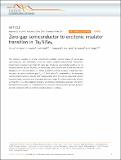Zero-gap semiconductor to excitonic insulator transition in Ta2NiSe5
Date
16/02/2017Metadata
Show full item recordAbstract
The excitonic insulator is a long conjectured correlated electron phase of narrow-gap semiconductors and semimetals, driven by weakly screened electron–hole interactions. Having been proposed more than 50 years ago, conclusive experimental evidence for its existence remains elusive. Ta2NiSe5 is a narrow-gap semiconductor with a small one-electron bandgap EG of <50 meV. Below TC=326 K, a putative excitonic insulator is stabilized. Here we report an optical excitation gap Eop ∼0.16 eV below TC comparable to the estimated exciton binding energy EB. Specific heat measurements show the entropy associated with the transition being consistent with a primarily electronic origin. To further explore this physics, we map the TC–EG phase diagram tuning EG via chemical and physical pressure. The dome-like behaviour around EG∼0 combined with our transport, thermodynamic and optical results are fully consistent with an excitonic insulator phase in Ta2NiSe5.
Citation
Lu , Y F , Kono , H , Larkin , T I , Rost , A W , Takayama , T , Boris , A V , Keimer , B & Takagi , H 2017 , ' Zero-gap semiconductor to excitonic insulator transition in Ta 2 NiSe 5 ' , Nature Communications , vol. 8 , 14408 . https://doi.org/10.1038/ncomms14408
Publication
Nature Communications
Status
Peer reviewed
ISSN
2041-1723Type
Journal article
Description
This work was partially supported by Grant-in-Aid for Scientific Research (S; grant no. 24224010) and by Grant-in-Aid for Scientific Research on Innovative Areas (grant no. JP15H05852). H.T. acknowledges support from the Alexander von Humboldt foundation.Collections
Items in the St Andrews Research Repository are protected by copyright, with all rights reserved, unless otherwise indicated.

